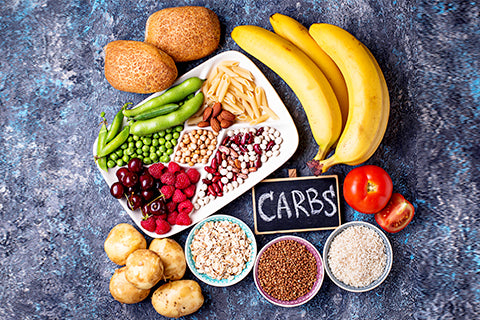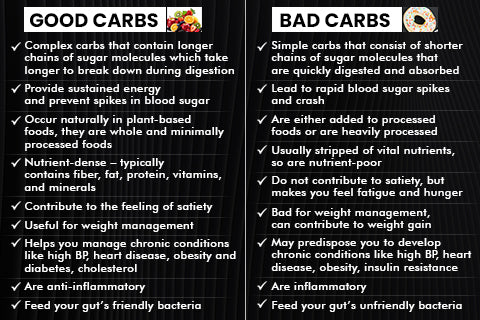March 16, 2024
Madhura Mohan
Good Carbs Vs Bad Carbs – What’s The Difference?
T
he thing is, in today’s world of fad diets and trendy eating plans, carbs often get a bad rep. With various diet patterns advocating for or demonizing carbs, the topic of good carbs vs bad carbs has stirred much confusion in the realm of nutrition. A lack of proper understanding of the diverse role carbs play in our health and well-being has led to a negative perception of carbs as a whole.
This blog aims to break it down for you and provide you with a comprehensive understanding of good carbs and bad carbs, and what makes them be termed good or bad.
Whether you’re looking to educate yourself about the carbs you consume, improve your overall health, or manage your weight, this blog is for you…
What Are Carbs?

Carbs or Carbohydrates are one of the three macronutrients essential for the body, alongside proteins and fats. Carbs serve as body’s primary source of energy and are found in a wide array of foods (fruits, vegetables, grains, legumes, dairy products, and sugars).
The chemistry definition of Carbs would be, compounds made up of carbon, hydrogen, and oxygen atoms.
There are three kinds of carbohydrates – fiber (complex carb), starches (complex carb), and sugar (simple carb).
Carbohydrates are found in both healthy and unhealthy foods. During digestion, Carbohydrates are broken down into simple sugars, which are then absorbed into the bloodstream and transported to cells to be used for energy.
You Just Read, Complex Carbs & Simple Carbs?

The topic was about good carbs, and bad carbs, right? Now, what do these complex carbs and simple carbs mean? We’ll simplify this for you, go ahead and read on…
Based on their chemical structure and how the body processes them, carbs are classified as simple carbs and complex carbs.
Simple carbs are composed of one or two sugar molecules, which are quickly digested and absorbed by the body. Simple carbs although provide quick energy, they are low in nutrients.
Examples of simple sugars – glucose, fructose, galactose, sucrose, lactose, maltose
Complex carbs are composed of long chains of sugar molecules, which take longer to digest and provide a sustained release of energy. Complex carbs contain fiber, vitamins, minerals, and provide additional nutritional benefits.
Examples of complex carbs – fiber and starch
We guess something is made clear now? Based on the structure, carbs are classified as simple carbs and complex carbs.
Good Carbs & Bad Carbs

The term, ‘good carb’ and ‘bad carb’ are colloquially used to categorize carbohydrates based on their nutritional value and impact on health.
The carbs that provide beneficial nutrients and promote overall health are referred to as good carbs.
The carbs that are less nutritious and may have negative effects on health are referred to as bad carbs.
In that sense, simple carbs are bad carbs and complex carbs are good carbs.
Examples Of Good Carbs – Fruits, vegetables, whole grains (brown rice, rye, barley, quinoa, oats, whole wheat bread), legumes (beans, lentils), starchy vegetables like sweet potatoes, nuts, seeds, millet, buckwheat, broccoli, spinach.
Examples Of Bad Carbs – Processed foods, sugary snacks, refined grains, sodas, desserts, sweetened beverages, candies, pastries, pasta, white rice, white sugar, high fructose corn syrup, sweets, white bread, cookies, cakes, sugar cereals, pastries, molasses.
Here, we’ll use the term ‘GI’ (glycemic index) to give you a much better knowledge on good carbs and bad carbs.
Understanding the GI will be crucial as it measures how quickly a carbohydrate-containing food raises blood glucose levels, which plays a role in distinguishing between good and bad carbs.
GI is a measure of how quickly a carbohydrate-containing food raises blood sugar levels after consumption. It plays a crucial role in distinguishing between good and bad carbs.
Good carbs (those with fiber, fat or protein) are foods with a low glycemic index, they have a slower absorption rate and lead to a gradual increase in blood sugar levels.
Bad carbs are foods with a high glycemic index, they are quickly digested and cause significant spikes in blood sugar levels.
The Way Bad Carbs Impact On Health

As we just mentioned, Bad carbs are quickly broken down into glucose and absorbed into the bloodstream, leading to a rapid spike in blood sugar levels.
-
Your body responds to elevated blood sugar by releasing the hormone insulin from the pancreas to help metabolize the sugars and bring sugar levels back to normal.
-
This is because high blood sugar levels are potentially very damaging and dangerous to the body. The rate at which insulin is released is largely dictated by how fast blood sugar levels rise. The faster the rise in blood sugar, the faster the rise of insulin levels.
-
While insulin is largely responsible for lowering blood sugar, it also plays a role in fat storage. As insulin levels rise, the machinery that stores fat gets turned on in direct relation. Higher insulin levels mean greater fat storage.
Are you feeling like, you should avoid carbs? No, you need not have to do that…..that’s why we highlighted the word, ‘bad carbs’.
Should You Or Should You Not Consume Carbs?
It is important to consume carbohydrates as part of a balanced diet, but the type and amount of carbs consumed should be considered.
As per USDA guidelines, 45% to 65% of the total daily calorie intake should come from carbs.
Conclusion
The composition of carbs (fiber content, vitamin, the structure) of carbs affects their nutrient content and the processing of carbs (its impact on blood sugar levels) relates to their classification as ‘good’ or ‘bad’.
Carbs aren’t inherently bad, it’s not the carbohydrates themselves that’s a cause of concern, it ultimately comes down to the quality of carbs.
Your goal shouldn’t be to eliminate all carbs but to spot healthy carbs. It is essential to focus on the overall quality of carbs in your diet and consider factors like fiber content, nutritional value, and portion sizes.
Understanding the difference between good carbs and bad carbs is crucial for maintaining a healthy and balanced diet.
So, How Can You Choose Wisely When It Comes To Carbs?

-
The classification of carbohydrates into ‘good’ or ‘bad’ categories is based on their nutritional value and impact on health.
-
When it comes to choosing carbs, opt for whole, unprocessed foods, whenever possible. Look for foods that are high in fiber and nutrients, and try to avoid foods that are high in added sugars and refined carbohydrates.
-
Focus on incorporating plenty of fruits, vegetables, whole grains, and legumes into your meals.
-
When choosing packaged foods, read labels carefully. Choose products with little to no added sugars. Look out for refined grains and fiber content and essential nutrients.
-
Minimize your consumption of sugary snacks, desserts, sodas, and sweetened beverages, which are sources of empty calories, and can contribute to weight gain and health issues. It’s okay to enjoy treats occasionally, but they shouldn’t be the main source of your carbs.
-
Choose foods with low glycemic index, pair your carb source with lean protein and healthy fats to create balanced meals.
-
If you’re still not clear on how to identify good carbs and bad carbs, just keep in mind that the closer a food is to its natural state, the more health-friendly carbs it contains.
Carbs aren’t the enemy, learn to spot healthy carbs…
We hope this blog serves to help you make smarter carbohydrate choices, and empower you to understand the nutritional value of the food you eat…




 Follow our Instagram page for the latest updates: badalkhudko
Follow our Instagram page for the latest updates: badalkhudko








Leave a comment